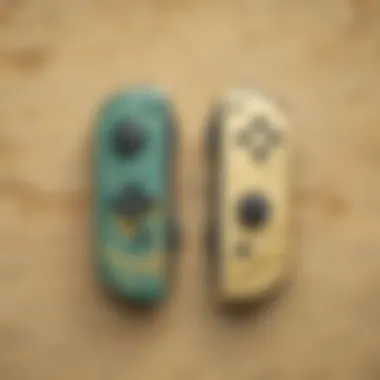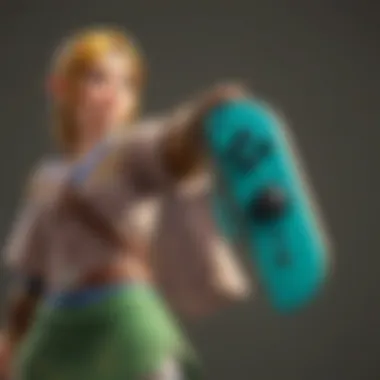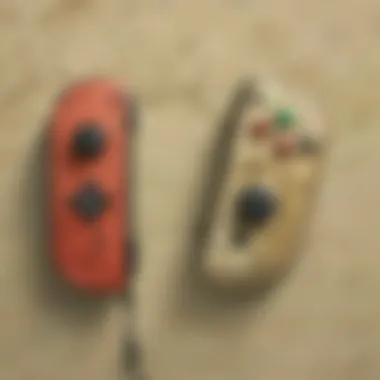Exploring Joy-Con Technology in Skyward Sword


Intro
The Legend of Zelda: Skyward Sword is not just another entry in the beloved franchise created by Nintendo; it’s a stunning tapestry of adventure woven with intricate mechanics and plots that keep players engaged. With the introduction of Joy-Con technology, the game offers a fresh lens through which to experience its depths.
Joy-Con controllers provide an innovative take on gameplay. Imagine swinging your sword, dodging attacks, or pulling off complex maneuvers with the flick of your wrist. This level of interaction redefines how players engage with the world and the characters that inhabit it. As the era of motion control continues to evolve, one can’t help but marvel at how this integration has not only changed gameplay mechanics but has also enriched the storytelling and immersion that players experience.
In this article, we'll explore how Joy-Con technology enhances various gameplay elements, from the intricate combat techniques to the depth of character interactions. Let's start our journey into the realms of Hyrule, observing how this technology breathes new life into a classic adventure.
Intro to Skyward Sword and Joy-Con
In the realm of video games, few franchises resonate as deeply as The Legend of Zelda. The series has consistently pushed the boundaries of gameplay innovation, and Skyward Sword, originally released for the Wii, offered a fresh take through its ambitious integration of motion controls. Fast forward to its HD remake for the Nintendo Switch, where the Joy-Con technology redefined how players interact with the game.
This section seeks to examine the intersection of Skyward Sword and Joy-Con technology, shedding light on the significance of this relationship. The Joy-Con not only enhances the player’s experience but also enriches the game's dynamics. It makes for a more immersive storytelling experience by allowing players to engage in sword fights and puzzles with intuitive gestures, turning each movement into a tactile adventure.
Moreover, this exploration will highlight specific elements that contribute to the overall enjoyment and strategic depth of the game. By adapting the classic gameplay to Joy-Con mechanics, Skyward Sword provides a seamless blend of action and exploration, resulting in a vibrant gaming atmosphere. Emphasizing the balance between technology and artistry, the section will pave the way for a deeper understanding of how joyfully handheld controllers have become integral to gaming narratives.
Overview of The Legend of Zelda: Skyward Sword
The Legend of Zelda: Skyward Sword marks a pivotal moment in the franchise’s timeline. Set at the very beginning of the Zelda chronology, it acts as a genesis tale for many elements present in the series. Players step into the shoes of Link, the protagonist, whose journey unfolds in the sky and the land below, creating a varied and rich experience that demands exploration and interaction.
Distinctively, Skyward Sword utilizes a stylized art direction reminiscent of watercolors, making the world feel both enchanting and alive. The narrative revolves around Link's quest to rescue his childhood friend, Zelda, all while battling evil beings aiming to disrupt the harmony of their world. The game is densely layered with lore and character development, serving not only as a quest but also a narrative that captivates the heart.
One of the key features of Skyward Sword is its motion control mechanics, which utilize the Wii MotionPlus accessory for precise movements. Here, the integration of Joy-Con technology brings these dynamics into a modern light, enhancing the possibilities of action and strategy. Players experience swordplay that correlates with their physical motions, making each strike feel significant and engaging.
The Role of Joy-Con in Modern Gaming
The advent of Joy-Con technology has revolutionized how players immerse themselves in video games. Unlike traditional controllers that rely primarily on thumbsticks and buttons, Joy-Con provides both motion controls and an ergonomic design that promotes fluid interaction with gaming environments.
With the capability of motion sensitivity, Joy-Con allows for an unparalleled level of precision and responsiveness. What was once exclusive to Skyward Sword becomes a standard operating feature in modern titles, demonstrating a shift in design philosophy. Players can now physically engage with the game, driving narratives forward by their actions rather than solely through commands.
Additionally, the flexibility of Joy-Con enables multiple configurations, accommodating various player preferences and gaming setups. Each player can customize their experience, whether opting for handheld mode, tabletop mode, or standard console mode, enhancing communal play opportunities. With such adaptability, Joy-Con not only highlights the distinctions of Skyward Sword but also draws parallels to the future of gaming, wherein physical engagement becomes integral to virtual experiences.
"The bridge between player and game has essentially been redrawn with the introduction of the Joy-Con, making every experience richer and more immersive."
In summary, the integration of Joy-Con technology into Skyward Sword dovetails with the game's overarching goals. It enhances moments of intensity, reflection, and strategic thought while maintaining a coherent narrative pathway. What begins as mere gameplay morphs into an extension of player expression, redefining not only how Skyward Sword is experienced but also how gaming is perceived as a whole.
Understanding Motion Control Mechanics
Understanding motion control mechanics in The Legend of Zelda: Skyward Sword is crucial as it shapes the very core of the player’s experience. This section will provide insights into the specific elements that make motion control a significant feature in the game, the benefits it brings, as well as considerations for players who wish to fully engage with the mechanics.
Technical Foundations of Motion Control
The technical foundations of motion control are rooted in the Joy-Con technology itself. These controllers utilize a combination of sensors, including accelerometers and gyroscopes, to detect orientation and movement. This means that the game can register not only simple button presses but also nuanced physical movements in three-dimensional space. By translating real-world actions into game mechanics, players can wield Link's sword in a way that's more intuitive than pushing a button.


For instance, when a player swings a Joy-Con, the game interprets this action as a sword strike. The precision of this technology allows for varied swings, whether they're vertical, horizontal, or even diagonal. The responsiveness and accuracy can elevate the experience immensely, turning a casual playthrough into a more immersive adventure.
It's important to note that for motion controls to be effective, the game must be designed with these mechanics in mind. Proper calibration and sensitivity settings are necessary. Skyward Sword does account for these factors, somewhat mitigating flailing, which can lead to frustrating gameplay. Players must also consider their surroundings; too much clutter can interrupt the sensors' ability to track the motion accurately, hence affecting the gameplay negatively.
Implementation in Skyward Sword
The implementation of motion controls in Skyward Sword is a prime example of how technology can innovate the gaming landscape. From the moment players pick up the Joy-Con, they can feel the difference. Actions such as drawing a bow or parrying an attack transform into physical endeavors that require more than just pressing a button.
The game employs motion control for various gameplay mechanics such as:
- Combat Strategies: Enemy encounters demand players to engage actively, making quick defensive and offensive movements rewarding both strategically and in terms of satisfaction.
- Exploration: Navigating dungeons and the open world implies a hands-on approach, where players must physically reach for items, defeat monsters, or solve puzzles.
- Puzzle Interactions: Certain challenges require specific motions, such as spinning a gear with a certain swing of the Joy-Con, adding uniqueness to each aspect of gameplay.
"Motion controls have not only enhanced the gameplay value but also breathed new life into familiar mechanics, providing a sophisticated layer of interaction."
Despite its advantages, players should count on a learning curve. Not everyone appreciates motion controls equally, and for some, they can feel cumbersome. Familiarity and practice become essential for mastering the nuances of gameplay. As games continue to evolve, understanding how to navigate and employ motion controls can provide a competitive edge and enrich the overall experience.
Ultimately, the motion control mechanics in Skyward Sword illustrate a significant step in gaming innovation, using Joy-Con technology to create a more engaging world that mirrors player actions in a way traditional controls cannot.
Player Experience and Engagement
The integration of Joy-Con technology in The Legend of Zelda: Skyward Sword takes player experience to the next level, allowing gaming enthusiasts to not just press buttons, but to immerse themselves in a vibrant and responsive world. This section delves into the unique aspects of player engagement that are shaped by motion controls, emphasizing how they enhance connection to in-game actions and environments.
Immersion through Interactive Gameplay
Immersion is the lifeblood of any engaging gaming experience; it’s what keeps players engrossed and invested in their journey. With the Joy-Con, Skyward Sword taps into this immersion by creating a more tactile interaction. Each swing of Link's sword feels like an extension of the player’s arm, translating real-world movements into in-game actions. This is vital, as it invites players to embody their character, not merely control them.
The dual approach of using both Joy-Con controls gives players a nuanced level of engagement. For instance, when solving puzzles that require specific motions, the gameplay transforms into an interactive spectacle. Imagine swinging the Joy-Con to slash through obstacles or to navigate through challenging environments, where every movement holds significance. This aspect can resonate particularly well with players who thrive on interactive storytelling, as it breaks down the barrier between the player and the digital world.
Feedback Mechanisms and Player Interaction
In conjunction with immersive gameplay, feedback mechanisms form the backbone of player interaction. The Skyward Sword experience relies heavily on the sensory feedback provided through the Joy-Con. From the vibrations mimicking the clash of swords to sound effects that play in sync with actions, these elements together create a sense of realism that traditional controls often lack.
Through rumble features, players can sense the intensity of their strikes or the proximity of enemies. The feedback serves not merely as a guide but as a motivator, encouraging further exploration and interaction. Here’s a breakdown of how effective feedback mechanisms impact gameplay:
- Reinforcement of Actions: Successful strikes or completed puzzles prompt satisfying vibrations, making each achievement feel tangible.
- Guidance in Challenges: Gentle vibrations may indicate an area of interest or hint at puzzle mechanics, keeping the player engaged without breaking immersion.
- Emphasizing Environmental Detail: The Joy-Con's ability to respond to various in-game scenarios allows players to feel the subtle differences in terrain or obstacles, enhancing the overall exploration experience.
"Feedback doesn't just inform players; it immerses them, creating an environment where every action is felt and understood."
Strategic Elements Enhanced by Joy-Con
In the realm of gaming, the intricacies of control schemes can often shape how immersive and strategic a game feels. In The Legend of Zelda: Skyward Sword, the integration of Joy-Con technology redefines this interaction, offering a range of strategic elements that enhance gameplay in noteworthy ways. The delicate balance between skill and spontaneity, coupled with the precision brought about by motion controls, creates an engaging environment for players to delve deep into the mechanics of combat and puzzles.
Combat Mechanics and Motion Sensitivity
When players pick up their Joy-Con to engage in combat within Skyward Sword, the experience takes on a visceral quality. The motion sensitivity of the Joy-Con allows players to use sweeping motions to execute sword slashes that feel almost lifelike. This not only adds excitement but also requires tactical decision-making. Players must think critically about their blade strokes, considering timing and direction, rather than simply button-mashing.


For instance, striking from above or sideways initiates different actions and effects in-game. This means that a diagonal swipe can yield a powerful downward thrust, encouraging players to adapt and tailor their movements based on enemy types. The system works effectively to create a more intense, hands-on approach to combat but also means that players can’t merely rely on button inputs. Each swing becomes a direct extension of the player's intention, which can lead to more satisfying victories or frustrating defeats based on the player’s skill.
Critically, the calibration of Joy-Con adds further layers to this system. If a player neglects the importance of precision in their motions, they may find themselves underwhelmed by combat encounters. That’s why mastering these mechanics often becomes a rite of passage for Zelda enthusiasts, challenging even seasoned players to revisit their strategies regularly.
Puzzle Solving with Motion Controls
Puzzles in Skyward Sword are another key area where Joy-Con technology shines. Traditional gameplay often involves static inputs, yet motion controls allow for a much more dynamic interaction with the game's environment. Players can tilt, twist, and manipulate objects around them in ways that feel intuitive and immersive.
For example, players may encounter puzzles requiring them to rotate blocks or manipulate entire mechanisms. Here, the Joy-Con becomes not just a controller but an essential tool for lateral thinking and spatial awareness. The act of gently tilting the controller to guide an object through a labyrinth not only engages the mind but also the body, turning players into active participants in the puzzle-solving process.
Moreover, this method of interaction encourages creativity. Rather than following a predetermined path, players can experiment with various angles and approaches to reach their goals. Engaging in such a tactile form of puzzle-solving is often seen as stimulating and rewarding.
Comparative Analysis: Traditional Controls vs. Joy-Con
The debate between traditional controls and the innovative Joy-Con system is as lively as a group of Gorons at a rock festival. Understanding this aspect is crucial not just for assessing the gameplay mechanics but also for exploring what truly resonates with players. Joy-Con technology brings something unique to the table, offering a blend of tactile feedback and intuitive motion controls. This section dives deep into the benefits and considerations between these two styles, shedding light on what makes every playthrough of The Legend of Zelda: Skyward Sword a distinct experience.
Historical Perspectives on Gameplay Controls
When you wind back the clock, it’s like riding a time machine to see how far we’ve come in gaming controls. Initially, games like the very first Zelda title relied heavily on button presses. There was no room for fancy movements; players were all about rapid thumb action. The controllers were simplistic, yet they birthed some iconic moments.
- The NES controller gave us the directional pad and a handful of buttons.
- The Nintendo 64 diversified the experience with its analog stick. Each iteration opened doors to immersive gameplay.
Fast forward to the Wii era, and we saw the introduction of motion controls that made players feel more connected to the action on the screen, using the controller to swing swords, aim arrows, and more. With Skyward Sword, Nintendo took this a step further by integrating the precise Joy-Con technology. Unlike the Wii's clunky sensor bar setup, Joy-Con allows for immediate response times, which game enthusiasts love.
Case Studies from Previous Zelda Titles
Looking at the Zelda franchise reveals a pattern of innovation and evolution that can’t be overlooked. The transition from traditional controls to the Joy-Con setup is neither random nor impulsive; it communicates a broader vision for interactive gameplay.
- The Legend of Zelda: Ocarina of Time: This title popularized the lock-on targeting system. Players managed combat and navigation with precision, but it still relied solely on button inputs.
- The Legend of Zelda: The Wind Waker: Sailing and combat mechanics showcased a charming art style with traditional controls still dominating. The controls felt natural, but player interaction was more passive.
- The Legend of Zelda: Twilight Princess: Introduced slight motion controls that allowed players to swing Link’s sword and aim his bow, but the implementation wasn’t as refined as the upcoming Skyward Sword.
With Skyward Sword, these previous designs laid the foundation for what was to come. The uniquely crafted joystick and motion-sensing capabilities allow users to slice through enemies, not just with the push of a button but with the graceful swing of their arms. It’s a paradigm shift that places the player at the helm, engaging them not just as passive observers but as true participants in Link's journey.
As the landscape of gaming control continues to evolve, it’s evident that Joy-Con technology will influence future iterations of the Zelda franchise and beyond. Players crave an experience that feels personal and immersive, bridging the gap between fantasy and reality in a beautifully orchestrated dance of interaction.
Character Interactions and Joy-Con Dynamics
In the world of The Legend of Zelda: Skyward Sword, character interactions play a pivotal role as they add layers of depth to the gameplay experience. The integration of Joy-Con technology enhances these interactions in ways that feel more genuine and responsive, thus transforming how players engage with not just Link, but also the myriad of characters populating the vibrant landscapes of Hyrule. Joy-Con motion controls do not merely replicate a button-press; they act as a bridge that intimately connects players to the emotional currents flowing through the narrative.
Link’s Interactions within the Gameplay
Link, as the courageous protagonist, embodies the very spirit of adventure. The Joy-Con technology allows players to experience Link’s interactions in a more tactile manner, making each encounter feel unique. Whether swinging a sword or using a shield, the motion-sensitive capabilities of the Joy-Con mirrors the fluidity of Link's actions on screen. When players lift their Joy-Con to swing Link's sword, it’s akin to an extension of their own arm, giving an empowering sensation of agency over an iconic character.
In addition to combat, Link’s interactions with various NPCs (non-playable characters) are transformed. Gestures, such as bowing or raising an item, cultivate a sense of realism. Players might find themselves naturally leaning into the Joy-Con to respond to an NPC's dialogue or using hand movements to signify emphasis during conversations. These moments not only enrich the storytelling but also draw players into the rich lore that the Zelda series provides.
Environmental Responses to Joy-Con Commands


The environment in Skyward Sword responds dynamically to Joy-Con commands, creating an engrossing gameplay experience. Players feel an added layer of immediacy as they manipulate their surroundings through motion controls. For instance, using a Joy-Con to launch an item or interact with objects in the game world fosters a relationship between the player and the environment that feels both immersive and intuitive.
When players physically swing the Joy-Con, they aren’t just controlling a character; they are influencing the game world directly. This realization evokes a sense of connection to the gameplay, as players witness the tangible effects of their motions reflected on screen.
For example:
- Puzzles: Joy-Con motion controls allow for complex puzzles where players must physically move items to solve challenges.
- Combat: Enemies react to the angle and force of Link's attacks, requiring thoughtful swings of the Joy-Con to succeed.
The use of Joy-Con technology not only refreshes familiar gameplay mechanics but also redefines the very essence of interactivity in The Legend of Zelda: Skyward Sword.
Ultimately, the character interactions and the responsive environments through Joy-Con commands serve to immerse players deeper into the gameplay, creating a multifaceted experience that respects the legacy of the Zelda series while pushing it toward exciting new territories.
Technological Advancements and Their Influence
The integration of Joy-Con technology has not just reshaped how players interact with The Legend of Zelda: Skyward Sword, but it has also influenced the very fabric of gaming as a whole. This section delves into its advancements, benefits, and implications, which are crucial to understanding the depth of player engagement this title achieves.
Evolution of the Joy-Con Technology
The Joy-Con controllers represent a significant leap forward in gaming technology that blends traditional and modern approaches. Initially launched with the Nintendo Switch, these controllers possess advanced motion sensing capabilities. The inclusion of gyroscopic sensors allows for precise movements, making gameplay not just reactive but dynamic.
Take a moment to consider how using a Joy-Con to swing Link’s sword feels different than merely pressing a button. The thrill of a swish emulating a real sword cut is something that joystick mechanics fail to replicate. Here’s how the Joy-Con makes that possible:
- Enhanced Motion Tracking: The precision sensors track even the slightest movements, turning every flick of the wrist into an action on screen.
- Customization Options: Players can configure Joy-Con controls to suit their play styles, enhancing comfort and responsiveness.
- Haptic Feedback: This feature provides tactile responses, making the sword's clash with an enemy all the more visceral.
In essence, the evolution of Joy-Con technology opened doors to a level of interactivity previously deemed unattainable. Uniting physical actions with in-game results, it sets the stage for more profound immersion in gaming narratives.
Future of Motion Controls in Gaming
As we look ahead, the future of motion controls is laden with potential. Developers are now acknowledging the unending possibilities that come with this technology. Here are some trends we might expect:
- Increased Realism: With advancements, motion controls may become more accurate, closely mirroring real-life movements. Imagine a world where you can draw a bow and arrow just like in real life—this could feasibly happen.
- Broader Game Genres: While Skyward Sword shines in action-adventure, expect motion controls to spill into additional genres such as puzzle games or simulations.
- Integration with AR and VR: The synergy between Joy-Con technology and virtual reality offers an exciting horizon for immersive gameplay, revolutionizing how stories are told and experienced.
The End and Final Thoughts
The exploration of Joy-Con technology within The Legend of Zelda: Skyward Sword reveals a fascinating interplay between hardware innovation and gameplay immersion. As we draw the curtains on this deep dive, it's essential to reflect on the overarching themes that have emerged throughout the article. The integration of motion controls significantly reshaped not just how players interact with the game's environment, but also how they embody the character of Link, all while engaging with the distinctly crafted landscapes of Hyrule.
Summary of Findings
The primary takeaway from our discussion can be distilled into several key points:
- Enhanced Immersion: Joy-Con motion controls create an unprecedented level of interaction, bridging the gap between the player and the game world. The act of swinging the sword or executing specific actions feels more tactile and real.
- Diverse Gameplay Strategies: Players are afforded new strategies in combat and puzzle-solving, allowing for a more dynamic approach to challenges. Each player's unique style comes to the fore, making personal flair a significant part of gameplay.
- Feedback and Engagement: With haptic feedback and motion sensitivity, the Joy-Con delivers a satisfying and enriching experience that keeps players engaged, responding to their actions in real-time.
Each finding reinforces the notion that Joy-Con technology is not just a gimmick; it’s a substantial upgrade that complements the narrative and design of Skyward Sword. The result is a compelling testament to the evolution of gaming as a whole.
Implications for Future Zelda Installments
Looking ahead, the implications of this integration are far-reaching. Here are some thoughts on potential directions for future Zelda titles:
- Adoption of Enhanced Motion Controls: As gaming technology continues to evolve, it's plausible that future Zelda games might incorporate even more advanced forms of motion capture and feedback, intensifying the player's connection with the game.
- Broader Application of Interaction: Future installments could further explore multi-faceted interactions where players could use Joy-Cons or similar technologies for intricate tasks, such as crafting or resource management, which could enhance the depth of gameplay.
- Storytelling and Environmental Interaction: Combining gameplay mechanics with narrative elements could lead to more immersive storytelling experiences, where the player's gestures directly affect the unfolding plot or character development.
In essence, the foundation laid by Skyward Sword using Joy-Con technology sets a high bar. Each Zelda game is a step forward in innovation and creativity, shaping the future of gaming. It stands as a reminder of how technology and gameplay can merge to create moments of pure joy and discovery.







